Oxidation Effects on Short-Term Creep Response in Air of Commercially Pure Titanium (CP-2 Ti)
Abstract
1. Introduction
2. Materials and Methods
3. Results
3.1. Creep Response
3.2. Oxidation and Hardening Effect: Microhardness Profiles
4. Discussion
4.1. Strengthening Role of Oxygen-Rich Layers
4.2. Constitutive Equation for CP-Ti (No or Minor Effects of Oxidation)
4.3. Quantification of the Effect of Oxidation on Creep Response
4.4. Critical Assessment of the Model
5. Conclusions
Author Contributions
Funding
Data Availability Statement
Acknowledgments
Conflicts of Interest
References
- Aniołek, K. The influence of thermal oxidation parameters on the growth of oxide layers on titanium. Vacuum 2017, 144, 94–100. [Google Scholar] [CrossRef]
- Chan, K.S.; Koike, M.; Johnson, B.W.; Okabe, T. Modeling of Alpha-Case Formation and Its Effects on the Mechanical Properties of Titanium Alloy Casting. Metall. Mater. Trans. 2008, 39A, 171–180. [Google Scholar] [CrossRef]
- Rosen, A.; Rottem, A. The Effect of High Temperature Exposure on the Creep Resistance of Ti-6AI-4V Alloy. Mater. Sci. Eng. 1976, 22, 23–29. [Google Scholar] [CrossRef]
- Poquillon, D.; Parrens, C.; Pugliara, A.; Perrais, M.; Malard, B. Oxidation of Ti–6Al–4V alloy between 450 and 600 °C. Evolution of microstructure and mechanical properties. MATEC Web Conf. 2020, 321, 06009. [Google Scholar] [CrossRef]
- Reis, D.A.P.; Piorino, F.; Barboza, M.J.R.; Nono, M.C.A.; Silva, C.R.M. Influence of the oxidation in creep of Ti-6Al-4V alloy. Acta Microsc. 2003, 12, 219–220. [Google Scholar]
- Magazzeni, C.M.; Gardner, H.M.; Howe, I.; Gopon, P.; Waite, J.C.; Rugg, D.; Armstrong, D.E.J.; Wilkinson, A.J. Nanoindentation in multi-modal map combinations: A correlative approach to local mechanical property assessment. J. Mater. Res. 2021, 36, 2235–2250. [Google Scholar] [CrossRef]
- Zheng Chen, G.; Fray, D.J.; Farthing, T.W. Cathodic Deoxygenation of the Alpha Case on Titanium and Alloys in Molten Calcium Chloride. Metall. Mater. Trans. 2001, 32B, 1041–1052. [Google Scholar] [CrossRef]
- Regev, M.; Almoznino, B.; Spigarelli, S. A Study of the Metallurgical and Mechanical Properties of Friction-Stir-Welded Pure Titanium. Metals 2023, 13, 524. [Google Scholar] [CrossRef]
- Kalienko, M.; Volkov, A.; Leder, M.; Zhelnina, A. Study of oxygen content in titanium alloys after exposure at elevated temperature. MATEC Web Conf. 2020, 321, 11068. [Google Scholar] [CrossRef]
- Gardner, H.M.; Gopon, P.; Magazzeni, C.M.; Radecka, A.; Fox, K.; Rugg, D.; Wade, J.; Armstrong, D.E.J.; Moody, M.P.; Bagot, P.A.J. Quantifying the effect of oxygen on micro-mechanical properties of a near-alpha titanium alloy. J. Mater. Res. 2021, 36, 2529–2544. [Google Scholar] [CrossRef]
- Vaché, N.; Monceau, D. Oxygen Diffusion Modeling in Titanium Alloys: New Elements on the Analysis of Microhardness Profiles. Oxid. Met. 2020, 93, 215–227. [Google Scholar] [CrossRef]
- Bregolin, F.L.; Behar, M.; Dyment, F. Diffusion study of 18O implanted into α-Ti using the nuclear resonance technique. Appl. Phys. 2007, A 86, 481–484. [Google Scholar] [CrossRef]
- Bieler, T.R.; Trevino, R.M.; Zeng, L. Alloys: Titanium, Encyclopedia of Condensed Matter Physics. In Encyclopedia of Condensed Matter Physics; Elsevier: Amsterdam, The Netherlands, 2005; pp. 65–76. [Google Scholar] [CrossRef]
- Ranganath, S.; Mishra, R.S. Steady state creep behaviour of particulate-reinforced titanium matrix composites. Acta Mater. 1996, 44, 927–935. [Google Scholar] [CrossRef]
- Spigarelli, S.; Paoletti, C.; Cabibbo, M.; Cerri, E.; Santecchia, E. On the creep performance of the Ti-6Al-4V alloy processed by additive manufacturing. Addit. Manuf. 2022, 49, 102520. [Google Scholar] [CrossRef]
- Spigarelli, S.; Paoletti, C.; Cerri, E.; Santecchia, C.M. Creep response of Ti–6Al–4V alloy produced by additive manufacturing: Effect of annealing at 1050 °C. Mater. Sci. Eng. 2022, A860, 144278. [Google Scholar] [CrossRef]
- Perez, R.A.; Nakajima, H.; Dyment, F. Diffusion in α-Ti and Zr. Mater. Trans. 2003, 44, 2–13. [Google Scholar] [CrossRef]
- Shahmir, H.; Pereira, P.H.R.; Huang, Y.; Langdon, T.G. Mechanical properties and microstructural evolution of nanocrystalline titanium at elevated temperatures. Mater. Sci. Eng. 2016, A669, 358–366. [Google Scholar] [CrossRef]
- Luo, S.D.; Song, T.; Lu, S.L.; Liu, B.; Tian, J.; Qian, M. High oxygen-content titanium and titanium alloys made from powder. J. All. Comp. 2020, 836, 155526. [Google Scholar] [CrossRef]
- Yu, Q.; Qi, L.; Tsuru, T.; Traylor, R.; Rugg, D.; Mo Rris, J.W.J.; Asta, M.; Chrzan, D.C.; Minor, A.M. Origin of dramatic oxygen solute strengthening effect in titanium. Science 2016, 347, 635–639. [Google Scholar] [CrossRef]
- Poulain, R.; Delannoy, S.; Guillot, I.; Amann, F.; Guillou, R.; Lartigue-Korinek, S.; Thiaudière, D.; Béchade, J.-L.; Clouet, E.; Prima, F. First experimental evidence of oxygen ordering in dilute titanium–oxygen alloys. Mater. Res. Lett. 2022, 10, 481–487. [Google Scholar] [CrossRef]
- Whittaker, M.T.; Harrison, W.J.; Lancaster, R.J.; Williams, S. An analysis of modern creep lifing methodologies in the titanium alloy Ti6-4. Mater. Sci. Eng. 2013, A577, 114–119. [Google Scholar] [CrossRef]
- Evans, R.W.; Hull, R.J.; Wilshire, B. The effects of alpha-case formation on the creep fracture propertied of the high-temperature titanium alloy IMI834. J. Mater. Proc. Technol. 1996, 56, 492–501. [Google Scholar] [CrossRef]
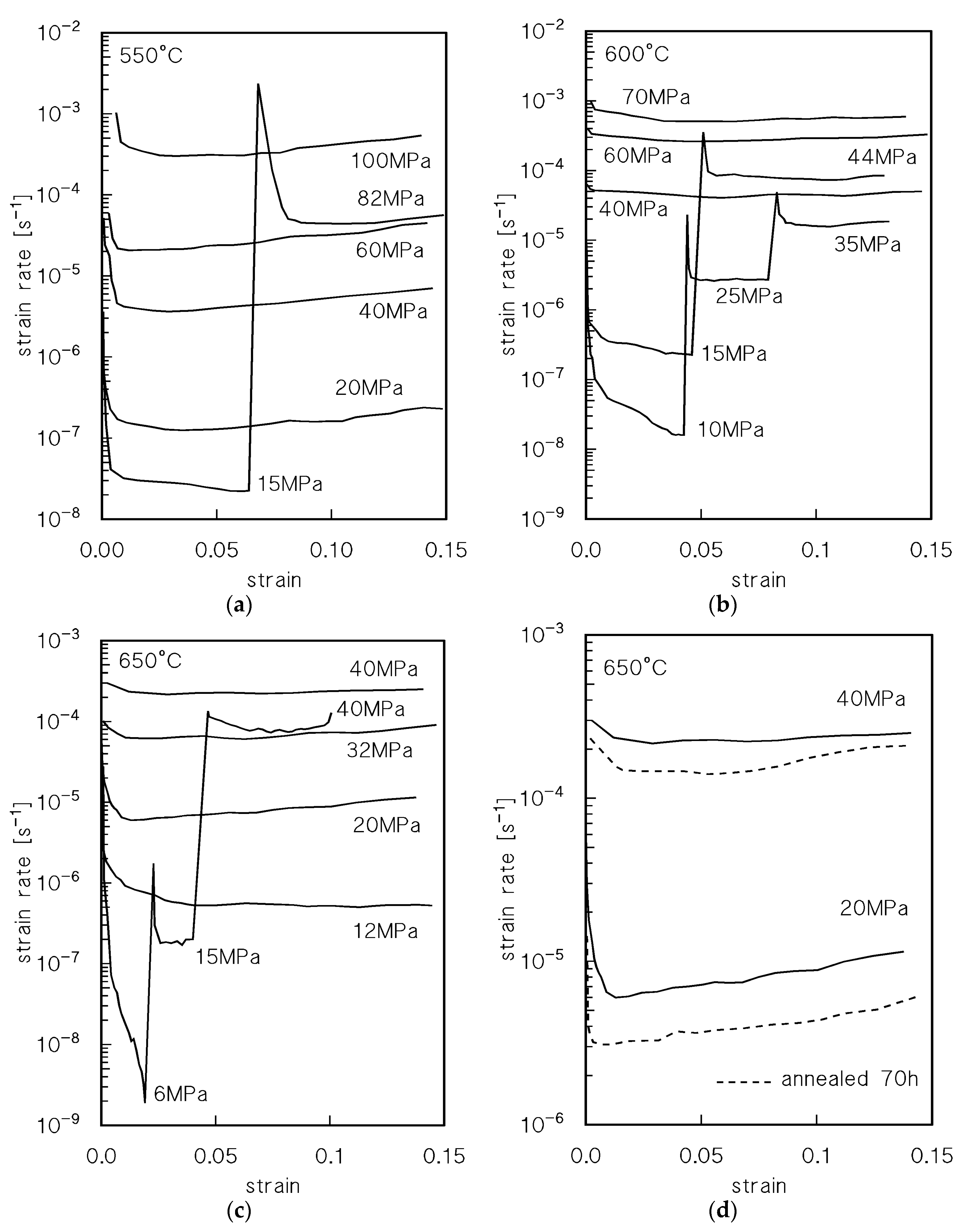
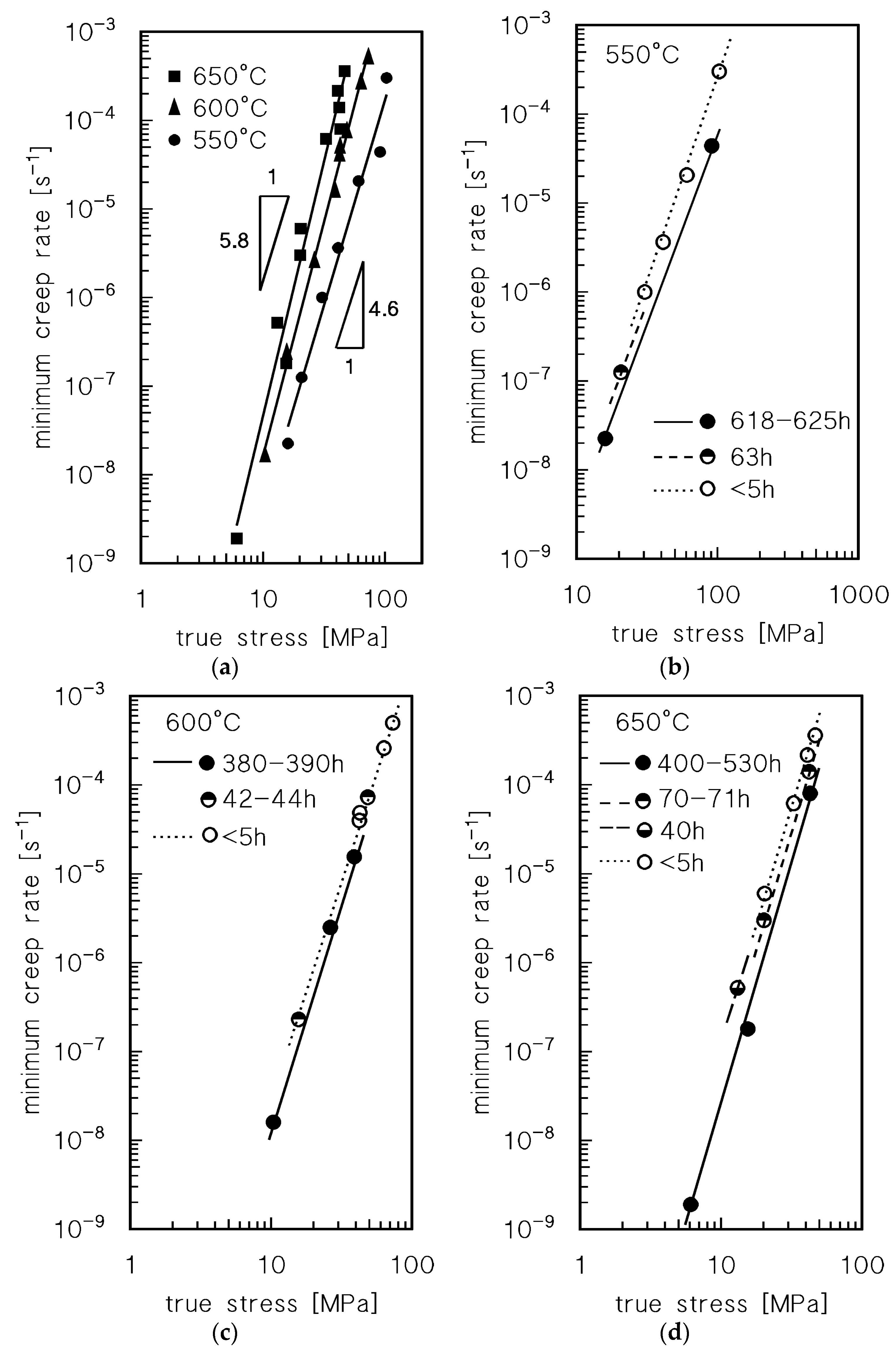
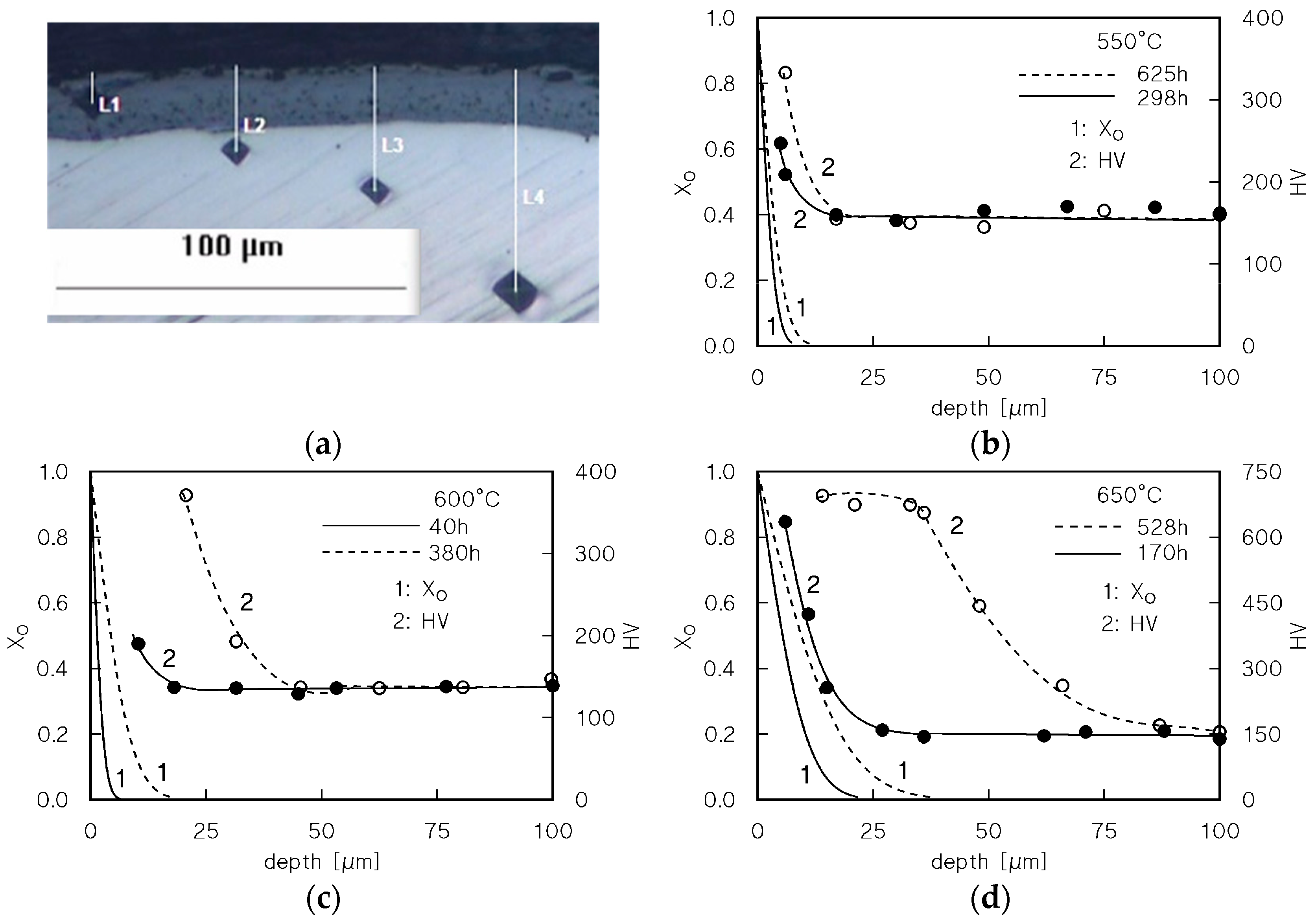
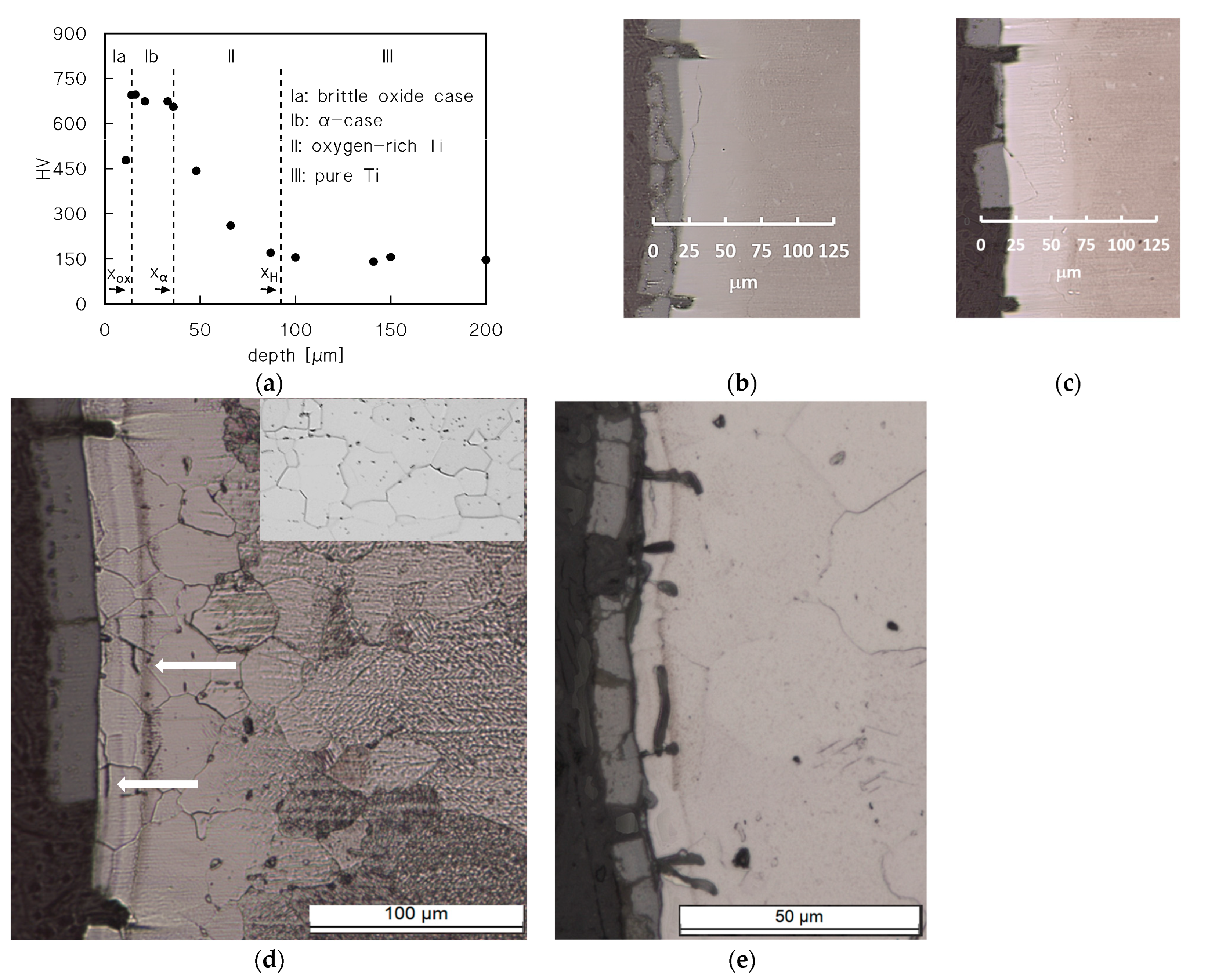

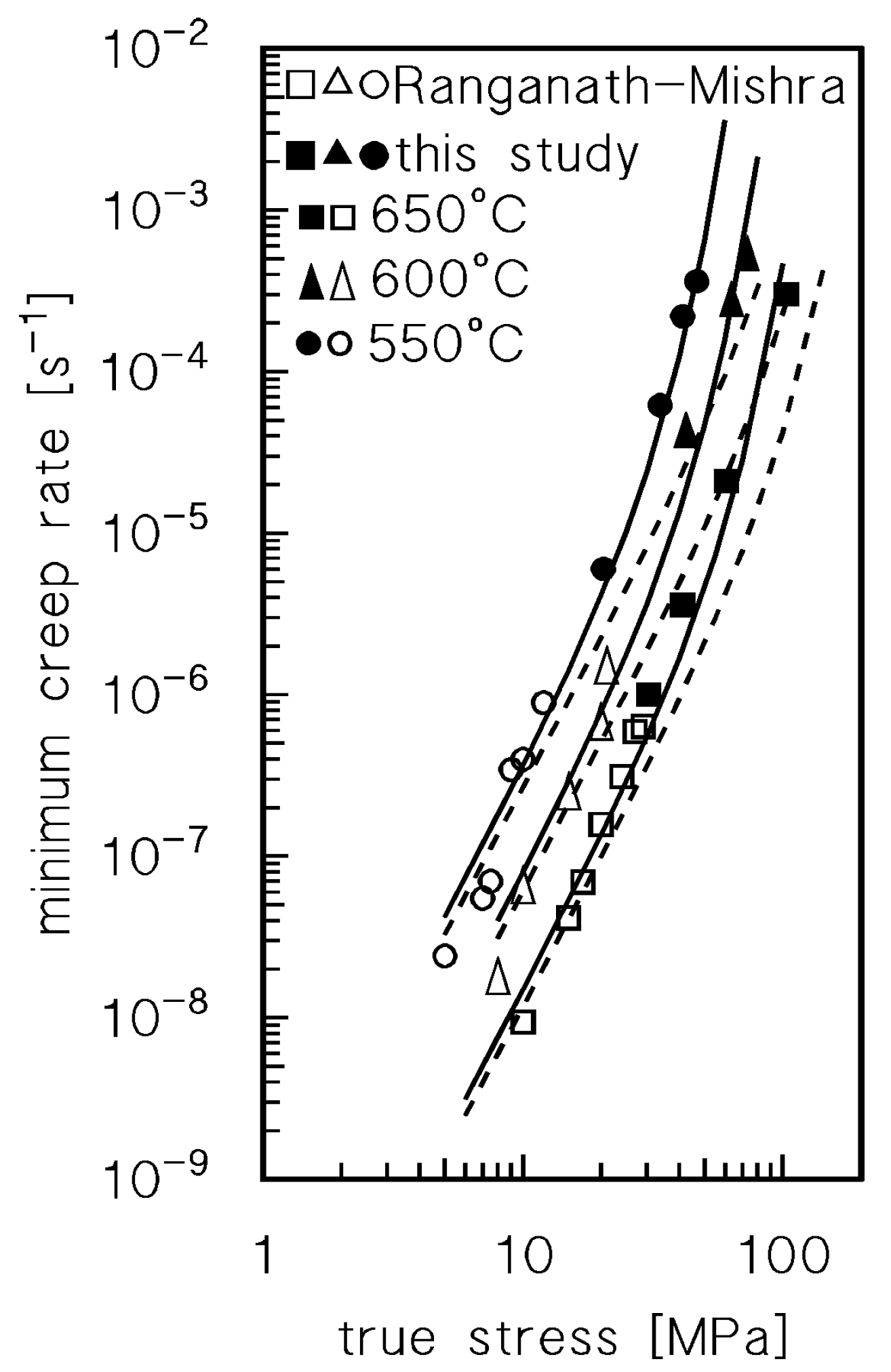

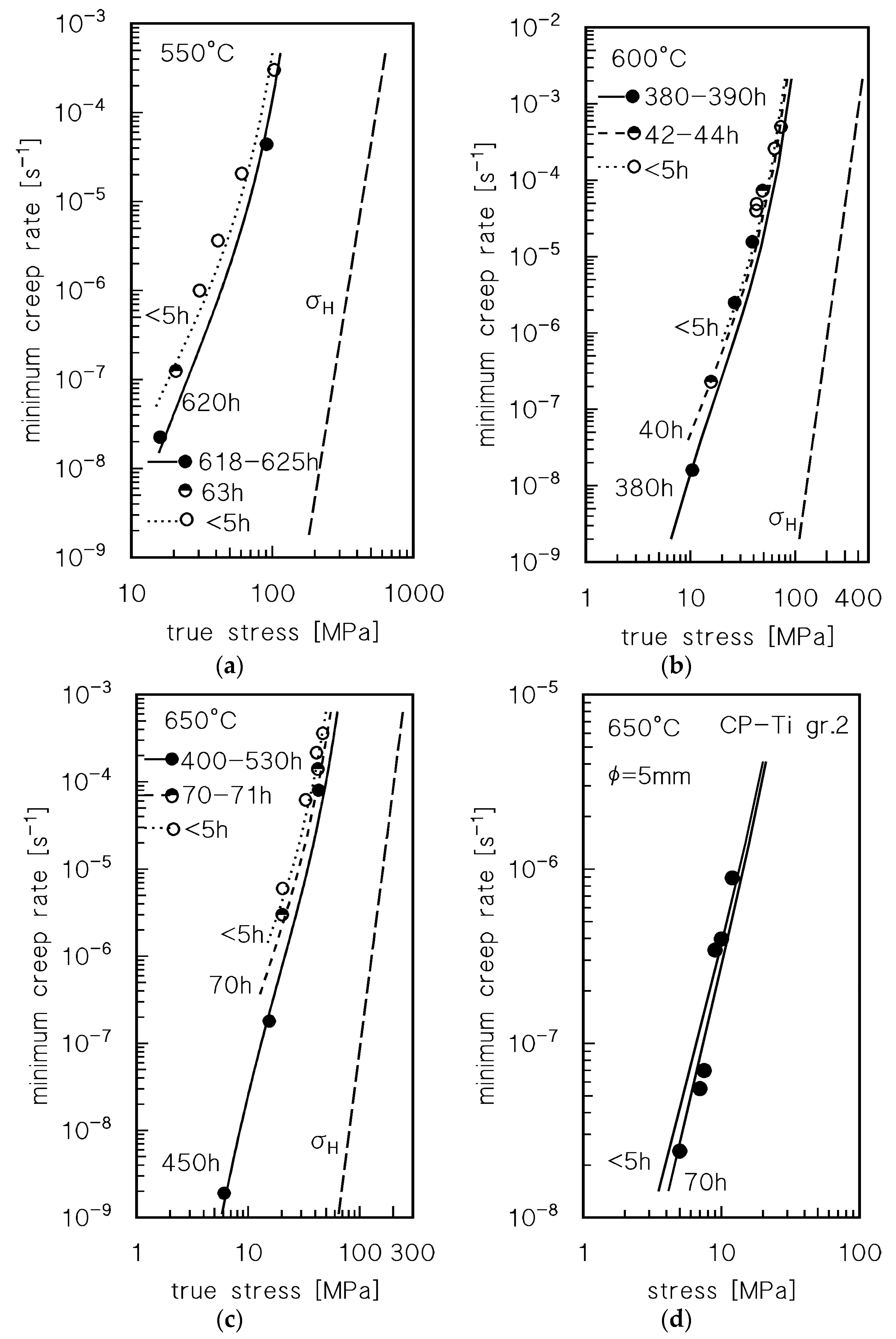

| Test | Temperature (°C) | Stress, Nominal (MPa) | Minimum Strain Rate (s−1) |
|---|---|---|---|
| VLE10 | 650 | 6 | 1.9 × 10−9 |
| 15 | 1.8 × 10−7 | ||
| 40 | 8.0 × 10−5 | ||
| VLE14 | 650 | 12 | 5.2 × 10−7 |
| 9.5 | 1.3 × 10−7 | ||
| CLE13 * | 650 | 20 | 3.0 × 10−6 |
| CLE01 | 650 | 20 | 6.0 × 10−6 |
| CLE05 | 650 | 32 | 6.2 × 10−5 |
| CLE02 | 650 | 40 | 2.2 × 10−4 |
| CLE08 * | 650 | 40 | 1.4 × 10−4 |
| CLE06 | 650 | 45 | 3.6 × 10−4 |
| VLE12 | 600 | 10 | 1.6 × 10−8 |
| 25 | 2.5 × 10−6 | ||
| 35 | 1.6 × 10−5 | ||
| VLE11 | 600 | 15 | 2.3 × 10−7 |
| 44 | 7.3 × 10−5 | ||
| CLE20 | 600 | 40 | 4.0 × 10−5 |
| CLE07 | 600 | 41 | 4.9 × 10−5 |
| CLE04 | 600 | 60 | 2.6 × 10−4 |
| CLE03 | 600 | 70 | 5.0 × 10−4 |
| VLE19 | 550 | 15 | 2.3 × 10−8 |
| 82 | 4.4 × 10−5 | ||
| CLE18 | 550 | 20 | 1.3 × 10−7 |
| CLE20 | 550 | 30 | 1.0 × 10−6 |
| CLE17 | 550 | 40 | 3.7 × 10−6 |
| CLE16 | 550 | 60 | 2.1 × 10−5 |
| CLE15 | 550 | 100 | 3.0 × 10−4 |
Disclaimer/Publisher’s Note: The statements, opinions and data contained in all publications are solely those of the individual author(s) and contributor(s) and not of MDPI and/or the editor(s). MDPI and/or the editor(s) disclaim responsibility for any injury to people or property resulting from any ideas, methods, instructions or products referred to in the content. |
© 2023 by the authors. Licensee MDPI, Basel, Switzerland. This article is an open access article distributed under the terms and conditions of the Creative Commons Attribution (CC BY) license (https://creativecommons.org/licenses/by/4.0/).
Share and Cite
Regev, M.; Santoni, A.; Spigarelli, S. Oxidation Effects on Short-Term Creep Response in Air of Commercially Pure Titanium (CP-2 Ti). Metals 2023, 13, 1275. https://doi.org/10.3390/met13071275
Regev M, Santoni A, Spigarelli S. Oxidation Effects on Short-Term Creep Response in Air of Commercially Pure Titanium (CP-2 Ti). Metals. 2023; 13(7):1275. https://doi.org/10.3390/met13071275
Chicago/Turabian StyleRegev, Michael, Alberto Santoni, and Stefano Spigarelli. 2023. "Oxidation Effects on Short-Term Creep Response in Air of Commercially Pure Titanium (CP-2 Ti)" Metals 13, no. 7: 1275. https://doi.org/10.3390/met13071275
APA StyleRegev, M., Santoni, A., & Spigarelli, S. (2023). Oxidation Effects on Short-Term Creep Response in Air of Commercially Pure Titanium (CP-2 Ti). Metals, 13(7), 1275. https://doi.org/10.3390/met13071275







